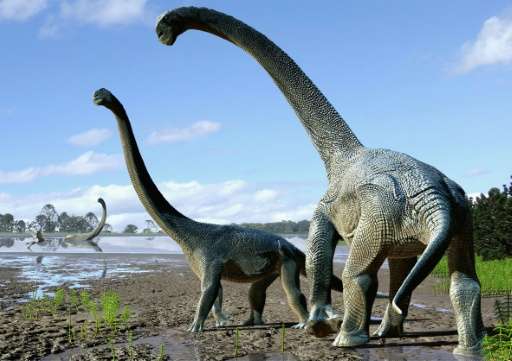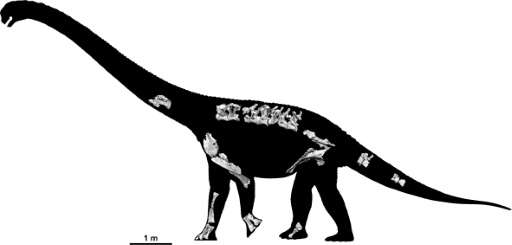Long-necked dino species discovered in Australia

Scientists unveiled fossils Thursday from a new species of giant, long-necked dinosaur unearthed in northeast Australia, speculating that its ancestors had trekked across Antarctica some 105 million years ago.
At least 14 metres (45 feet) from head-to-tail, Savannasaurus elliottorum was a plant-chomping, barrel-chested member of the sauropod group, which includes the largest land animals to ever have roamed the planet.
The discovery, along with a specimen of another sauropod called Diamantinasaurus matildae, was detailed in the Nature journal Scientific Reports.
Palaeontologists nicknamed the two dinos Wade and Matilda. Both species are thought to be unique to Australia.
How and when these and other dinosaurs made it Down Under is a source of ongoing debate, and the new find is sure to add fuel to the fire.
Some experts say they arrived far earlier than the 80-million Cretaceous period, which ended with a cataclysmic bang some 66 million years ago.
But the new find points to another scenario, said Stephen Poropat, a scientist at Uppsala University in Sweden and lead author of the study.
"We suggest that our sauropods evolved from South American ancestors," he told AFP.
These would have crossed a land bridge onto Antarctica, skirted its edge, and then crossed another bridge to Australia.
During most of the Cretaceous, Poropat said, the polar continent would have been too cold for these lumbering herbivores to have survived the trip.

A giant toe bone
But a window opened about 105 million years ago, earlier research has shown, warming the region enough to make a southern passage possible.
"Antarctica was not frozen over, as far as we know, at any time" from 251 to 66 million years ago, he said in an email exchange.
Indeed, fossil records show that the landmass today covered with a two-kilometre thick blanket of ice was then dense with forests.
Because there was no ice on either pole, a spike in temperatures would not have lifted oceans—as is happening today—to erase land bridges on either side of Antarctica.
S. elliottorum was named for Australian paleontologist David Elliot, co-founder of the Australian Age of Dinosaurs Museum—which will house the new finds—and a co-author of the study.
Elliott stumbled across bone fragments jutting up from the ground in 2005 while herding sheep near his home by the Winton geological formation, site of many earlier discoveries.
"I was hoping it might be a meat-eating theropod dinosaur," he recalled in a statement.
But Elliott quickly realised it was something else when his wife Judith, also a scientist, clicked two pieces of bone together and held up a complete toe-bone from a leaf-eating sauropod.
After a decade of work—painstakingly removing hard siltstone from a truckload of rock-encrusted bones—they revealed one of the most complete sauropod skeletons every found in Australia.
Journal information: Scientific Reports
© 2016 AFP



















